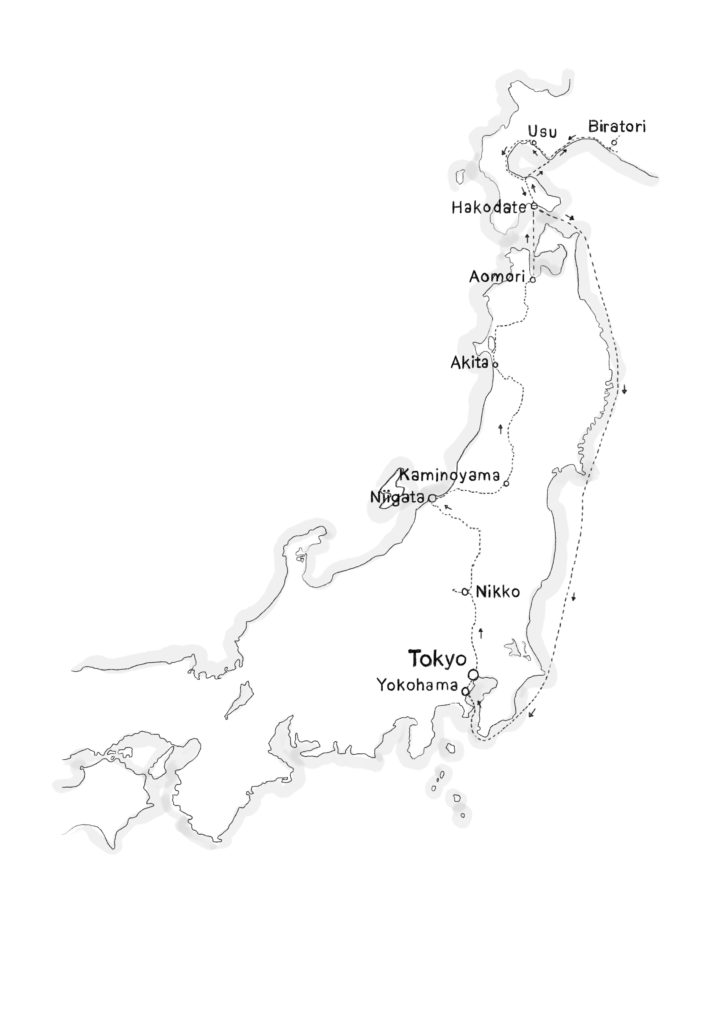In the summer of 1878, the English geographer and travel writer Isabella Bird made an extraordinary expedition through the North of Japan. With rare license to travel beyond the main treaty ports, Bird covered ground where few (if any) Westerners had set foot. Accompanied by the teenage interpreter Ito Tsurukichi, Bird traversed from Yokohama to Biratoi (Hokkaido) through the interior of Tohoku.

Then a sprightly forty-seven, Bird was no stranger to the hardships of Victorian era adventuring. Having suffered from a number of health conditions from a young age, her doctor prescribed an outdoor lifestyle as a kind of cure-all. With the blessing (and financial backing) of her clergyman father, Bird had set out on a life of travel at a young age, visiting every continent (save for South America) during the course of her life, and writing about the experiences in numerous travelogues.
Despite a relatively low profile in modern times, her detailed documentation of these lengthy missions makes her among the most accomplished traveler chroniclers of her era. Bird was the first woman to be elected to the Royal Geographical Society, and her keen knowledge of botany, geology and chemistry elevated much of her work above the romanticism of Victorian travel literature.
In Japan, where Bird spent seven months, she meticulously recorded daily life in Japan’s interior and the surrounding natural and built environment. Her northern expedition, which forms the basis for her book Unbeaten Tracks in Japan,was undertaken by rickshaw, packhorse, and on foot, covering over 1400 kilometers of mountainous terrain. While her personal safety was rarely threatened, perilous river-crossings, unpredictable horses and her general condition provided a suspenseful backdrop to the day-to-day.
Bird encounters many sites and landscapes that would remain familiar to a modern audience. These unchanging landmarks (such as the Cryptomeria avenues and temples of Nikko) help to impart a timelessness to her adventure and are part of its enduring popularity. Yet, it is through her honest interactions with local people – including a memorable stay in the company of an Ainu chieftain, Penriuku at Biratori – where her value as a documentarian shines.

Although Japan had been ‘opened’ to the West for nearly two-decades, Bird sought to access information and experience not yet available to the English-speaking world. With the assistance of British and Japanese government officials, Bird was able to secure unprecedented freedom of movement – alongside generous hospitality. Accommodations, travel arrangements and even pre-arranged cultural performances were carefully laid on throughout her journey – often at odds with the image she presented to audiences back home.
Far from the solo wanderings of a middle-aged adventurer, this orchestration tied into a secondary objective of seeking opportunities for Christian missions – a fact that is largely absent from the abridged, popular volume of her book. Perhaps because of this, Bird’s voice in Unbeaten Tracks is frequently a source of frustration. Like many Victorian travelogues, the language can be challenging in both style and content and Bird’s attitude and reporting often default to moralizing, prejudice and flagrant bigotry – all the while maintaining her defiantly observational tone. Although reflective of bygone attitudes, the text is frequently confronting in its xenophobia and outdated colonial language and tone.
In spite of such warranted misgivings, Isabella Bird’s journey and work is still a valuable account. The scope of her achievement, her fearless, analytic approach and the scientific credibility she draws, are important reasons for the continued popularity of her writing. Unbeaten Tracks remains a fascinating record of the rapid transformation of the Japanese countryside in the late nineteenth century.












